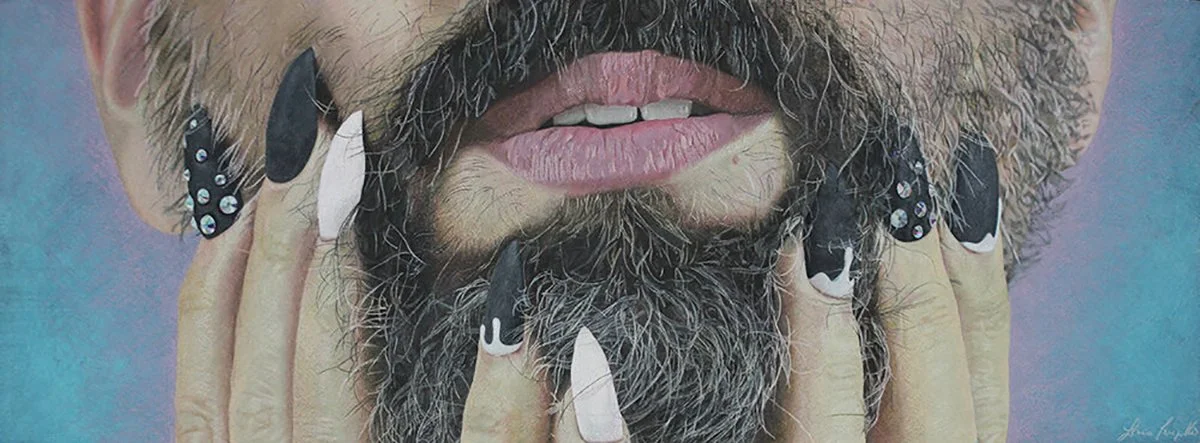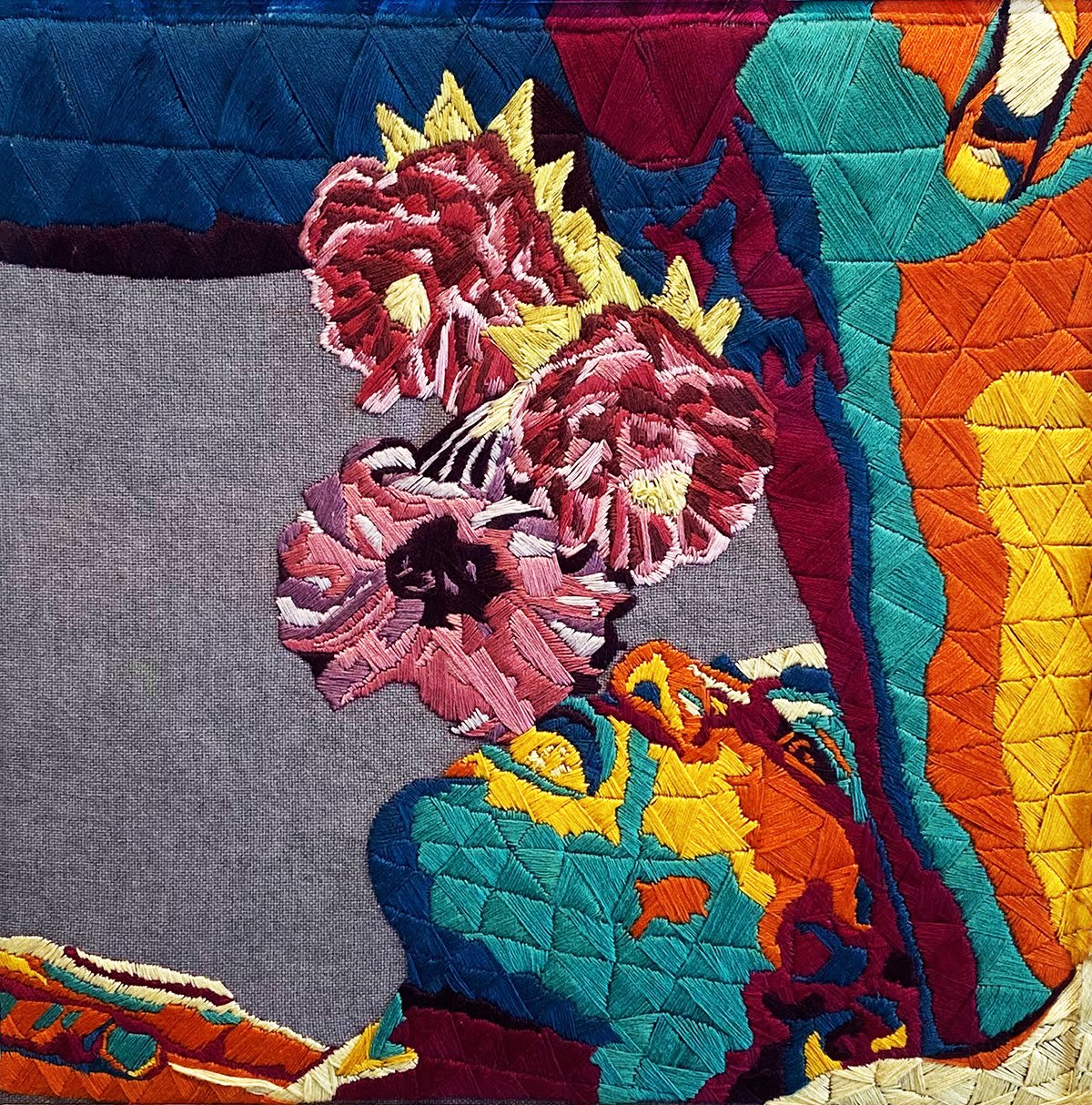Us
Us: A Showcase of LGBTQ+ Artists (Third Annual Exhibition)
Bitfactory Gallery
851 Santa Fe Drive, Denver, CO 80204
June 18-July 9, 2022
Admission: Free
Review by Ashten Scheller
Now at Bitfactory Gallery, the exhibition Us is a celebration of queer joy, community, and identity. An annual exhibition (this year being its third), its intent is “to bring attention and awareness to marginalized groups of artists and [to demonstrate] the universal nature of art.” [1] Showcasing members of the LGBTQIA+ community, works by artists Christopher La Fleur, James Mullane, Clint Ramstetter, and Louis Trujillo fill the gallery with primarily two-dimensional works: paintings, fiber art, and drawings.
James Mullane, Blowing Angel’s Trumpet, 2017, DMC embroidery floss on hand-dyed Ava Evenweave embroidery fabric, 20 x 20 inches. Image by Ashten Scheller.
Upon entering the space, visitors are greeted by James Mullane’s colorful fiber works. Pieces such as Blowing Angel’s Trumpet (2017) and Spreading that Seed (2019) combine both organic and geometric shapes to create detailed portraits of queer individuals interacting with various flowers. The images are both sexual and sensual as they explore the relationship between humans and nature.
James Mullane, Spreading that Seed, 2019, DMC embroidery floss on hand-dyed Ava Evenweave embroidery fabric, 20 x 20 inches. Image by Ashten Scheller.
Dandelion seeds and angel’s trumpet flowers are paired with queer bodies, with some images more overtly suggestive than others. Each act on display is performative, as though the viewer has caught the subject in the middle of an intimate deed. Additionally, the layering of the physical fiber embroidery thread works as a nod to the many interlocking layers of an individual’s identity.
Christopher La Fleur, Attention Whore, 2021, acrylic on cardboard, 40 x 30 inches. Image by Ashten Scheller.
Nearby, Christopher La Fleur’s King of Peace (2022) and Attention Whore (2021) demand attention in the entryway room. Both paintings are acrylic, the former on canvas and the latter on cardboard, employing a graphic quality that aggressively states “I am here—look at me and acknowledge my presence.” King of Peace presents a captivating image of a masculine figure, mouth covered by (or perhaps comprised of) a graphic rainbow. Right-side-up, the rainbow is possibly a frown, but its two clouds remain playful with their own cartoon-esque faces.
A view of Christopher La Fleur’s King of Peace, 2022, acrylic and Moroccan sand on primed canvas, 42 x 52 inches, on display at Bitfactory Gallery. Image by Ashten Scheller.
The background is brightly patterned with varying stars and stripes, and the central figure appears to be wearing a quiver of arrows. Is he prepared for battle, or in the midst of one? Is the equals sign that adorns his cheek—often used as a symbol for queer marriage equality—also doubling as a smear of war paint? The combination of intense colors and graphic mark-making tells us that there is an active life here, and one that is worthy of a fight.
Clint Ramstetter, Tools, 2022, oil on canvas paper, 20 x 16 inches. Image by Ashten Scheller.
Moving into the next gallery space, a far more subdued, contemplative environment reigns due to Clint Ramstetter’s Tools (2022). In this smaller, more intimate still-life oil painting the artist makes use of a limited color palette that one might find in an academic study. It depicts an arrangement of a human skull, an anatomical human figure, and an animal skull. As with many portrayals of skulls, this could be a memento mori—a symbolic reminder of the inevitability of death. Simultaneously, the human figure may act as a reminder of that which makes us human and what we do in our years of life. By adding the animal skull, our reading can deepen to include contemplation of what might (or might not) separate us from the animal world.
Clint Ramstetter, Paul, 2022, oil on canvas, 20 x 16 inches. Image by Ashten Scheller.
Elsewhere, Ramstetter’s oil on canvas portraits such as Simon (2022) and Paul (2022) depict members of the queer community in expressive, engaging manners. Paul sits cross-legged on a stool in what appears to be a back alley, wearing a pink tutu and voluminous white wig as he smokes a cigarette. His attitude is one of calm confidence as he welcomes the viewer’s gaze but does not return it. In contrast, Simon wears only a baseball cap, bright blue briefs, and a chunky metal watch—he is otherwise nude, and looks directly at the viewer as he leans backward. To meet his gaze is almost a dare, or perhaps an invitation. Ramstetter imbues his portraits with an energetic life force, allowing us to envision the lives and personalities of his subjects.
Louis Trujillo, Rugged and Rhinestoned, 2020, colored pencil on paper, 15 x 40 inches. Image courtesy of the artist.
Louis Trujillo rounds out the group with several works, each a detailed colored pencil portrait but in various sizes and formats. His pieces such as Rugged and Rhinestoned (2020), Lace (2019), and A Great Blow (2019) are beautiful examples of photorealism. In each, the singular figure—most, if not all, Trujillo himself—clearly takes identity and gender expression as their central focus. Cultural elements and adornments such as bejeweled fingernails, luxurious long hair, strappy high heels, and red lace underwear contrast with thick beards and masculine bodies. Trujillo exemplifies gender and sexuality as the spectrums they are: there are no binaries here. There is, however, a wondrous expression of joy and self-confidence.
Louis Trujillo, A Great Blow, 2019, colored pencil on paper, 11 x 22 inches. Image courtesy of the artist.
Though the artists on display create a beautiful representation of a portion of the queer community, I would be remiss not to voice a desire to see the inclusion of queer women and trans artists as well. Us, as an overarching and all-encompassing theme, is not complete without a fuller spectrum. That being said, Bitfactory Gallery’s aim of fostering inclusion is one that all galleries should emulate and employ—and not only during Pride Month. The energy, beauty, and contemplation of identity on display here belongs in all spaces.
Ashten Scheller is a Denver-based art historian, writer, and researcher, as well as a volunteer assistant editor for the intersectional online arts platform Femme Salée. She holds a BA in Art History and International Studies from the University of Denver and a Master’s degree in Art History, Theory, and Display from the University of Edinburgh.
[1] From the exhibition statement.















